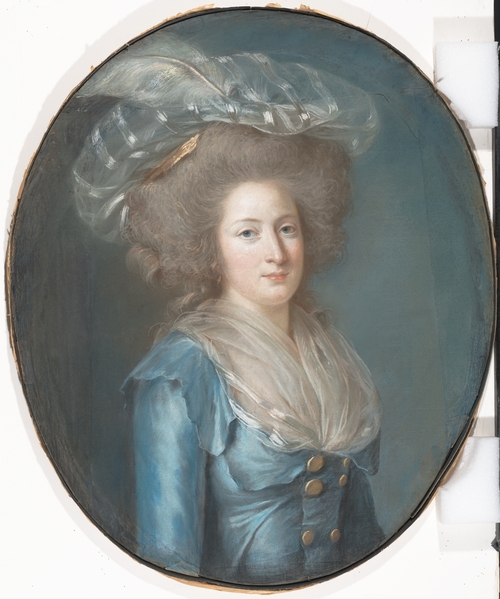Un pastel de A Labille-Guiard à voir à New York

In accordance with her usual practice, Labille-Guiard must have prepared the present pastel from life sittings, later bringing it to a high degree of finish, in preparation for the large and much more elaborate three-quarter-length portrait in oils (private collection) which she exhibited at the Salon of 1787 to high praise. The simple costume the Princess wears for this study sets off her face and accords well with the gentle reserve of her manner. She wears a redingote with gold buttons and a starched fichu. A muslin cap rests on her fair hair, which is dressed wide and lightly powdered: the artist has picked out some of the individual strands in a variety of delicate colors. The work was later enlarged and the additions to the original sheet of paper were painted by another hand.
ProvenanceAdélaïde Labille-Guiard, Paris (until d. 1803); François-André Vincent, Paris (1803–d. 1816; his estate sale, Paris, October 17–19, 1816, no. 56, listed among pastels as "Celui de Madame Élisabeth," for Fr 200 to Capet); Marie Gabrielle Capet, Paris (1816–d. 1818; posthumous inv., November 14, 1818, as "Un portrait au pastel de Mme Élisabeth par Me Guiard sous verre et cadre doré, prisé 50 F"); Jacques Mayer (in 1909); [Madame Louis (Elisabeth Wildenstein) Paraf, Paris, by 1963]; [Galerie Pardo, Paris]; [William H. Schab Gallery, New York, until 1969; sold to Stafford]; Mrs. Frederick M. Stafford, New York and New Orleans (1969– 2007)
Exhibition History
Paris. Palais de Bagatelle. "Portraits de femmes sous les trois Républiques," 1909, no. 128 (lent by M[onsieur]. J. Mayer).
New York. William H. Schab Gallery. "Pastel and Gouache Drawings of the Eighteenth Century from French Collections," October 17–November 15, 1969, no. 22.
New York. Wildenstein. "The Odyssey Continues," November 17, 2006–February 9, 2007, no. 37 (as lent from a private collection, New Orleans).
New York. The Metropolitan Museum of Art. "Pastel Portraits: Images of 18th-Century Europe," May 17–August 14, 2011, no. 27.
References
Roger Portalis. Adélaïde Labille-Guiard (1749–1803). Paris, 1902, pp. 87, 94.
Gabriel Mourey. "Exposition rétrospective de portraits de femmes sous les trois Républiques au Palais de Bagatelle." Les Arts 8 (July 1909), p. 28.
Pastel and Gouache Drawings of the Eighteenth Century from French Collections. Exh. cat., William H. Schab Gallery. New York, 1969, unpaginated, no. 22, ill., compares this pastel with Labille-Guiard's 1787 full-length portrait of Mme Adélaïde [château de Versailles], "whose pose, coiffure, and facial expression are very similar".
Anne-Marie Passez. Adélaïde Labille-Guiard, 1749–1803: Biographie et catalogue raisonné de son oeuvre. Paris, 1973, pp. 172, 178, 312–13, no. 76, pl. LXIII, calls it a pastel replica of "the original" (no. 72, present location unknown, exh. at the Paris Salon of 1787) or a preparatory study for it; provides detailed provenance information and publishes the contents of the 1816 posthumous sale of Labille-Guiard's husband, F.-A. Vincent, and the 1818 posthumous inventory of Mademoiselle [Marie Gabrielle] Capet, both of which included this pastel.
Neil Jeffares. Dictionary of Pastellists Before 1800. London, 2006, p. 271, ill., calls it a study for Ref. Passez 1973, no. 72 [the lost portrait of Madame Élisabeth exhibited at the Salon of 1787].
The Odyssey Continues: Masterworks from the New Orleans Museum of Art and From Private New Orleans Collections. Exh. cat., Wildenstein. New York, 2006, pp. 239–40, no. 37, ill. (color), date it about 1787.
Mark Ledbury. "Greuze in Limbo: Being 'Betwixt and Between'." French Genre Painting in the Eighteenth Century. Washington, 2007.
Mary Sprinson de Jesús. "Adélaïde Labille-Guiard's Pastel Studies of the Mesdames de France." Metropolitan Museum Journal 43 (2008), pp. 157–72, figs. 1 and 10 (color, overall and detail), discusses it in relation to Labille-Guiard's pastel portraits of Madame Adélaïde and Madame Victoire [see Notes]; identifies them as "among a very few pastel studies, handled with great immediacy, that prepared the way for her more ambitious, monumental portrait style"; remarks that these studies were "produced at the very end of the great age of pastel, at a moment when the artist herself was in the process of evolving from pastelist to oil painter"; views them as more direct reflections of their sitters' characters than Labille-Guiard's finished oil paintings.
Laura Auricchio. Adélaïde Labille-Guiard: Artist in the Age of Revolution. Los Angeles, 2009, p. 123, no. U18, calls it a study for the portrait of Madame Élisabeth sold at Piasa, Paris, in 1996.
Katharine Baetjer and Marjorie Shelley. "Pastel Portraits: Images of 18th-Century Europe." Metropolitan Museum of Art Bulletin 68 (Spring 2011), pp. 11, 38–39, no. 27, ill. (color, detail).
Gallery LabelThis pastel is a study for the oil portrait of Madame Élisabeth (private collection) that Labille-Guiard showed at the Salon of 1787. The sitter, the youngest sister of Louis XVI, chose to follow the King and Marie-Antoinette to imprisonment and the guillotine rather than abandon them for exile. This remarkably spontaneous work shows Labille-Guiard at the moment of her transition from pastellist to portrait painter, launched through the accomplished "Self-portrait with Two Pupils" (exhibited in European Paintings, gallery 2) that she showed at the Salon of 1785.
